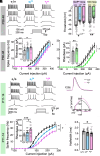Correction for Brill et al., Dissociation of SYNGAP1 enzymatic and structural roles: Intrinsic excitability and seizure susceptibility
- PMID: 40773241
- PMCID: PMC12358899
- DOI: 10.1073/pnas.2518853122
Correction for Brill et al., Dissociation of SYNGAP1 enzymatic and structural roles: Intrinsic excitability and seizure susceptibility
Figures


Erratum for
-
Dissociation of SYNGAP1 enzymatic and structural roles: Intrinsic excitability and seizure susceptibility.Proc Natl Acad Sci U S A. 2025 May 6;122(18):e2427288122. doi: 10.1073/pnas.2427288122. Epub 2025 Apr 28. Proc Natl Acad Sci U S A. 2025. PMID: 40294267 Free PMC article.
Publication types
LinkOut - more resources
Full Text Sources

